Imagine an assistant that captures everything you hear, transcribes it, translates it if necessary, summarizes it, classifies it, and fits in the palm of your hand. Here is the Plaud NotePin, a funny little object shaped like a pill, which promises to save you a ridiculous amount of time. I had the opportunity to test it in real conditions, particularly in the sound hell of CES 2025, and I must say I was not expecting to be so impressed. It's simple: I can no longer do without it! Alright, let me introduce it to you in more detail without further ado…
Unboxing and Presentation of the Plaud NotePin
The Plaud NotePin is available in a black box or a white box. The black box, which costs €20 more, contains several optional accessories worth €49. That’s the version I received, and for the price difference, I can only recommend it, as the accessories are really handy!
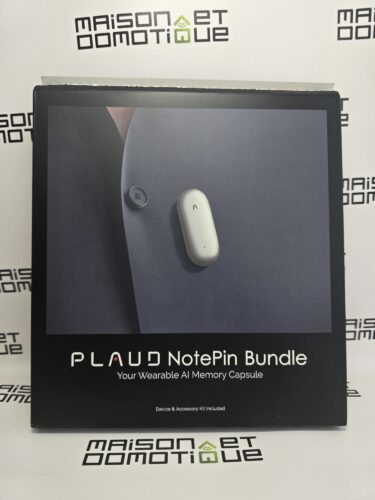
This main box contains two other boxes: one for the NotePin, the other for the accessories.

We open the first box and, surprise, we discover the NotePin, which looks like a mini capsule, halfway between a fitness tracker and a wireless earbuds case.

It is tiny, as light as a feather (you quickly forget about it around your neck or attached to your shirt), and the finish inspires confidence. Three colors are offered: cosmic grey, lunar silver, and violet sunset. Everyone will find their style, even though the look remains understated and professional.
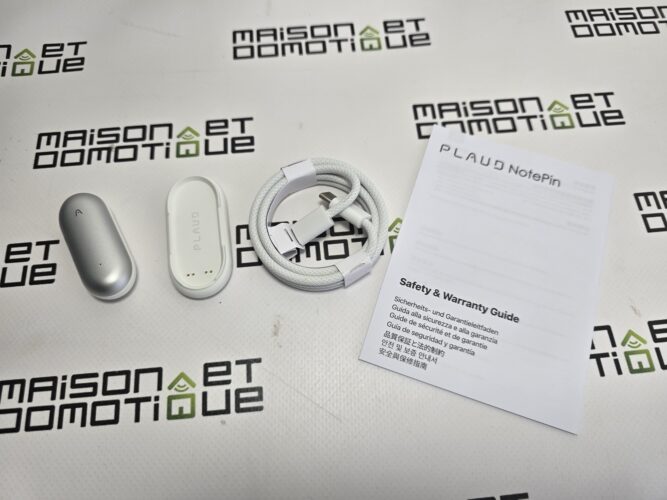
The packaging is clever: everything is designed to fit into your daily life.
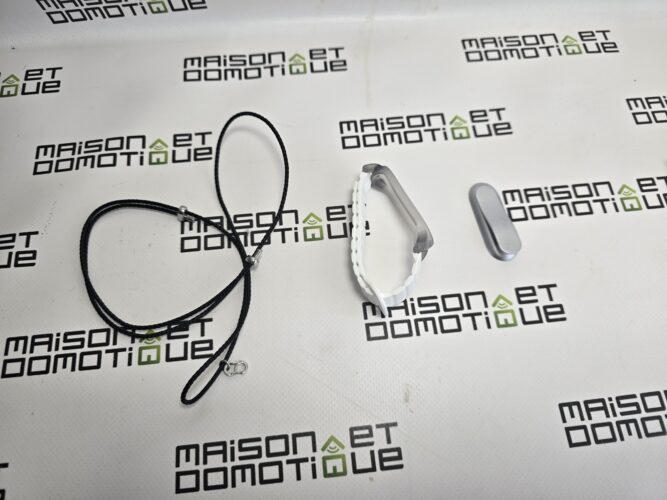
A necklace to always have it within reach, a bracelet styled like a smart watch, and a magnetic clip to attach it wherever you like.

You can feel that the brand has thought of varied uses: teachers, doctors, journalists, salespeople, students… even the most distracted will no longer be able to say “I forgot to take notes!”.
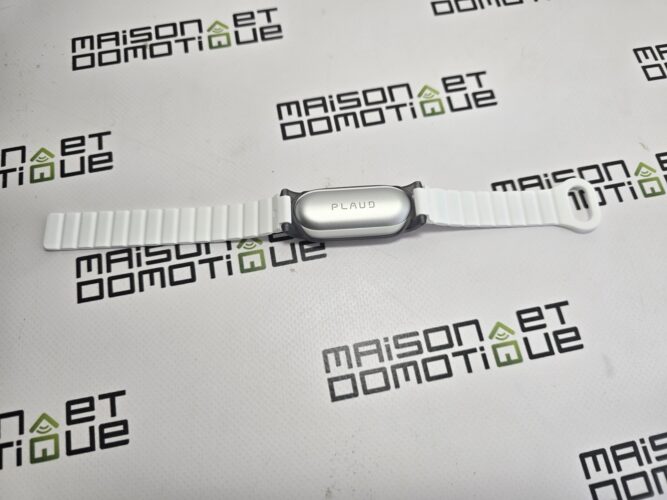

Despite its compactness, the NotePin offers 20 hours of continuous recording and up to 40 days on standby. No need to recharge it every few days, and it is so discreet that you almost forget to plug it in (it happened to me, I admit!).

To recharge, a small USB-C dock is provided. You simply need to remove the back of the NotePin (which is magnetic) and place it on its dock. Everything is magnetic and will not move.
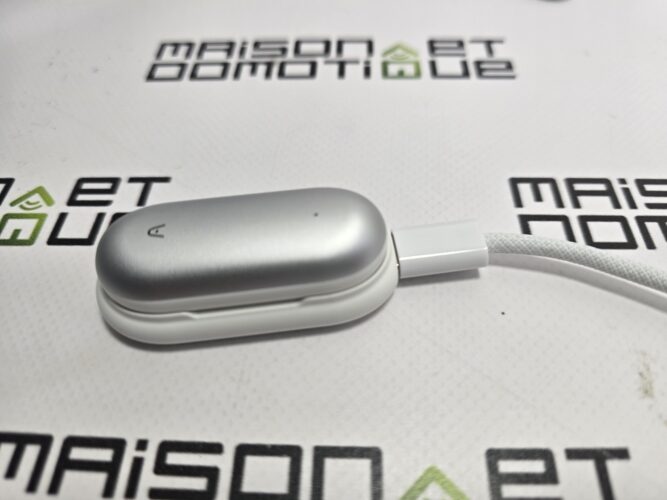
Configuration and Discovery of the Plaud NotePin
First contact: you download the Plaud app (available on Android and iOS), turn on the NotePin (a reassuring little vibration), and voila, Bluetooth pairing happens in a few seconds. The app interface is clear: no frills, it gets straight to the point. You find all your recordings organized, with the option to rename them, tag them, share them, or archive them in the cloud.
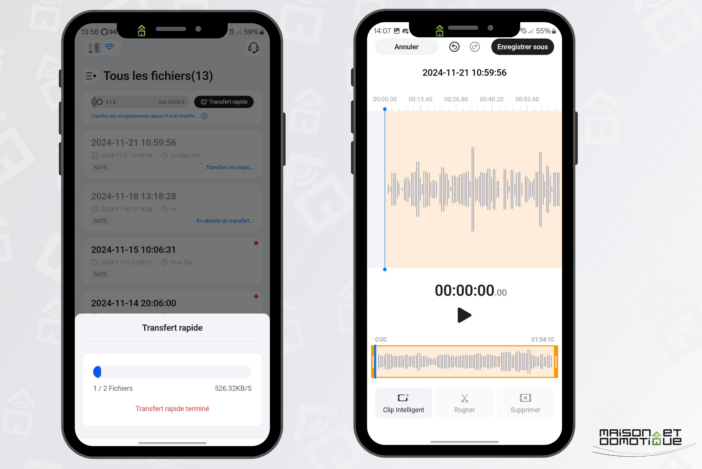
The real stroke of genius is the choice of AI models to process your notes. You can select between ChatGPT-4o or Claude 3.5 Sonnet according to your preferences. More models will be added gradually, with the latest version of ChatGPT o3-mini already in beta in the app.
The app offers over 30 formatting templates: meeting minutes, summaries, mind maps, to-do lists, summaries for students, etc. There’s even an “autopilot” mode that automatically adapts the structure according to the context. Convenient when you’re not quite sure what you want but want it to work for you. Generally, this mode works quite well!
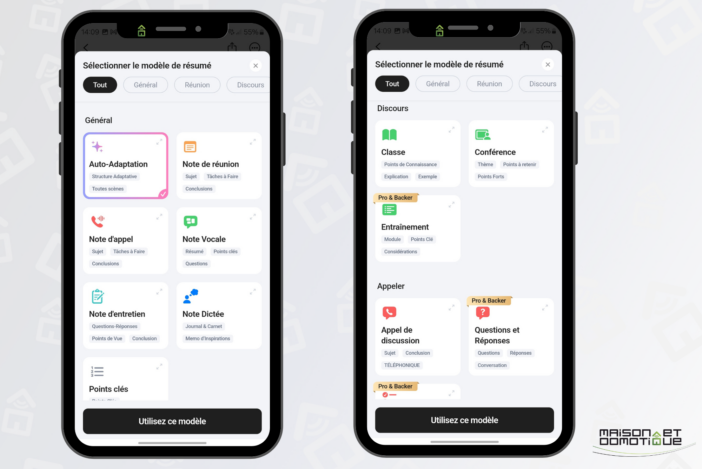
The Plaud NotePin comes with a package of 300 minutes of transcription per month (or 5 hours). This already meets many needs. But for heavy users (journalists, lawyers, doctors, teachers…), you'll need to upgrade to the Pro subscription (20h/month for €7.40). For very heavy users, an unlimited plan is also available at €21/month.
The app manages multi-platform synchronization: you can access your notes on smartphone, tablet, or PC, all secured and encrypted in the cloud.
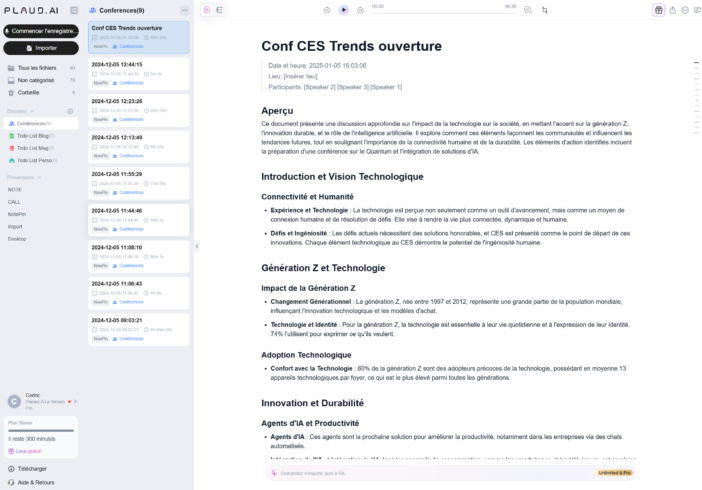
User Feedback: Plaud NotePin in the Field
I have been using the Plaud NotePin for 5 months now, and I have put it to the test in very varied situations. The most extreme? CES 2025, a temple of noise, overlapping conversations, and impromptu interviews. Usually, even the best recorders get lost: distant voices, background noise, approximate transcriptions… Here, the NotePin performed with honors. It captures the main voices (sometimes even better than my own ears!), distinguishes the speakers, and the transcription is remarkably accurate, even with accents, hesitations, or language switches along the way (it manages 112 languages, including French!). Clearly, at CES, it amazed me and greatly assisted me in producing and translating interviews for writing my articles—a considerable time saver!
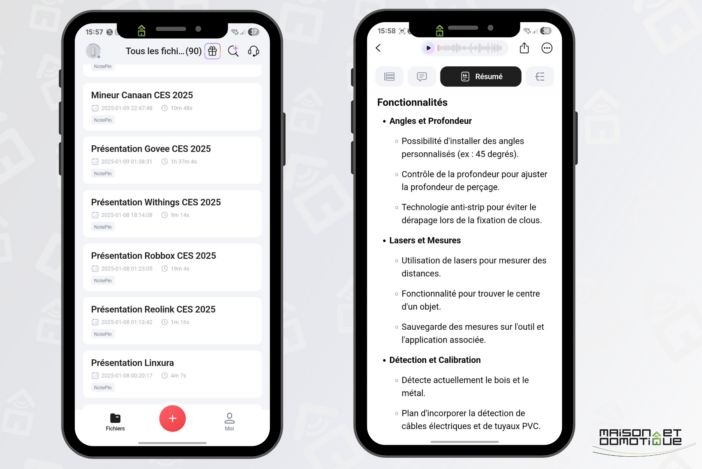
Another test: an editorial meeting with several participants. The NotePin was able to identify who was speaking, segment the exchanges, and generate a structured report in just a few seconds. I could even request an “action points” summary to extract tasks to do, or a mind map to visualize the main ideas. A real pleasure to save time and not forget anything.
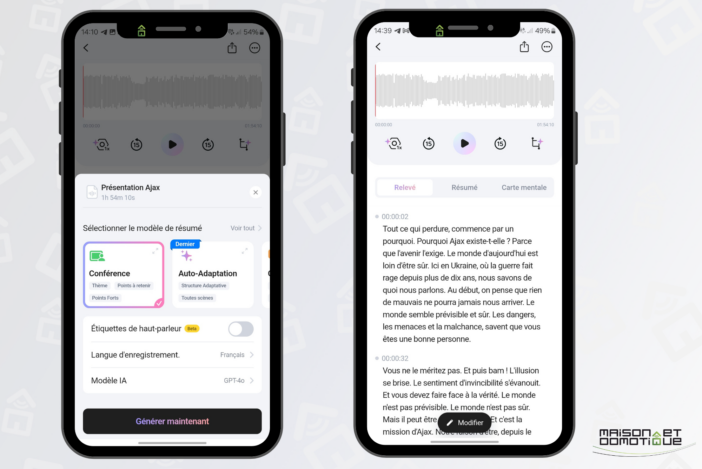
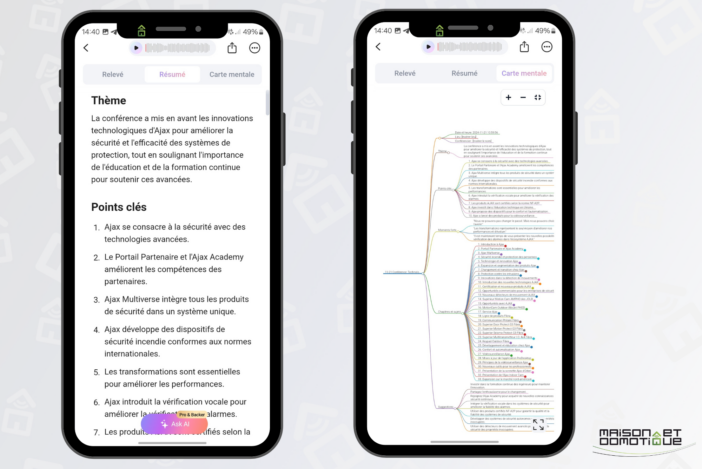
In client meetings, the NotePin is forgotten on the lapel of the jacket. One press, it activates, and you can concentrate on the exchange without having your nose in your smartphone.
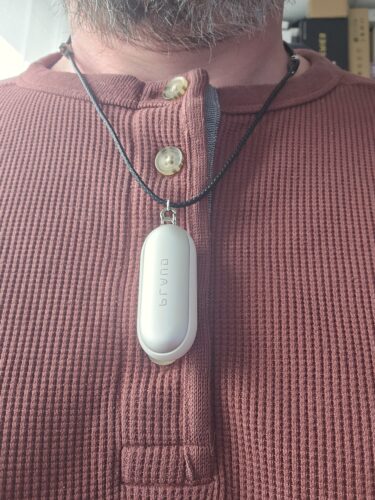
At the end, the app offers a summary ready to be emailed or shared with the team. For journalists, real estate professionals, doctors, trainers, it is a valuable ally to keep an accurate record of each interview.
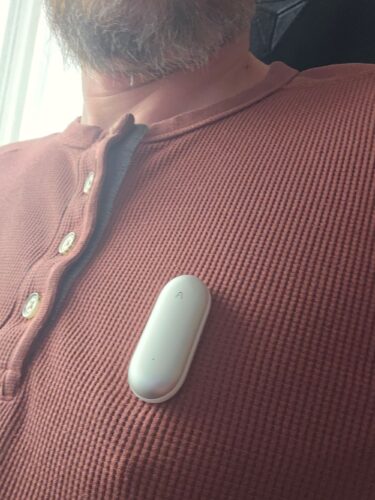
Even at home, it finds its place: family brainstorming, shopping lists, project ideas… We record, and the AI sorts it out. I even tested it by recording classes for my children: the transcription is accurate, and the summary allows for review without rereading entire pages.
Plaud NotePin vs smartphone voice recorder
One might think: “Another gadget, while my smartphone already does all that!” I was the first to think that when my friend Julien told me about it months ago. Well, not quite. I compared the NotePin with the voice recorder of my Samsung Galaxy S24 Ultra, which also offers AI for transcription and summarization in its Voice Recorder app. On paper, both do the job. But in use, the differences are striking.
First, discretion and speed: no need to unlock your phone, search for the app, start recording… A tap on the NotePin, and it’s on. In meetings or interviews, it changes everything: you stay in the moment without losing the thread.
Next, the quality of capture. The NotePin is optimized to isolate voices, even in the noise. It distinguishes several speakers, where the smartphone often mixes everything up. The transcription is more precise, especially in noisy environments like trade shows or open spaces. Despite its compact size, the technology embedded for sound capture is impressive.
On the AI side, the NotePin also goes further: selection of models, varied templates, mind map generation, action extraction… Where the Samsung mostly offers a basic summary, the NotePin provides a real range of tools to organize, synthesize, and share notes. You can feel that the device has been designed for professionals who want to work quickly and efficiently.
Finally, autonomy and portability make a difference. The smartphone is already used for everything, and the battery drains quickly. The NotePin, on the other hand, dedicates itself to a single mission, and it does it well. It becomes a dedicated assistant, always ready, and won’t give out after two hours of a meeting. In use, it offers extreme comfort!

What Plaud NotePin Offers More (and Points to Watch)
The NotePin is a bit of the missing link between the classic dictaphone that many professionals still use (many journalist colleagues in particular), and the AI assistant of tomorrow. It frees the mind, automates note-taking, and saves precious time. No more juggling between recordings, manual transcriptions, translations, and organizing ideas: everything is centralized, structured, and ready to use. You can thus focus on writing our articles, which is the true culmination of all this work, without wasting hours on preliminary data processing.
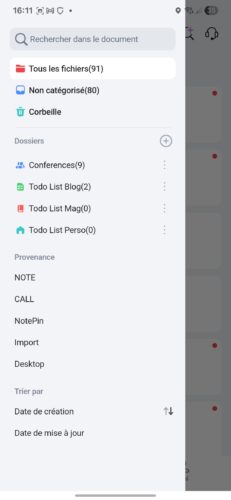
The Plaud NotePin shines particularly in noisy environments, situations where multiple voices need to be captured, or when you want to generate quickly usable summaries. Students, journalists, doctors, salespeople, teachers, but also creatives will find it useful. You can even imagine unexpected uses: note-taking during a cooking workshop, remembering a conversation with a loved one, or archiving ideas on the fly. I actually use it a lot in this context. I often have many ideas in my head that I previously noted down in Google Keep, which is very handy for that. Today, I just need to pinch my NotePin, which I often wear around my neck, and the idea is recorded. At the end of the day, it gives me a summary of it all.
It also has a large community and developers who are very attentive. Indeed, every month a vote is held on the new features to be developed as a priority. This is how the location feature was born for those who easily misplace their NotePin (currently available via Apple Find My, and soon on Android).

A Windows application (and soon Mac) has also appeared to record meetings via the internet on a computer (Google Meet, Zoom, etc.).
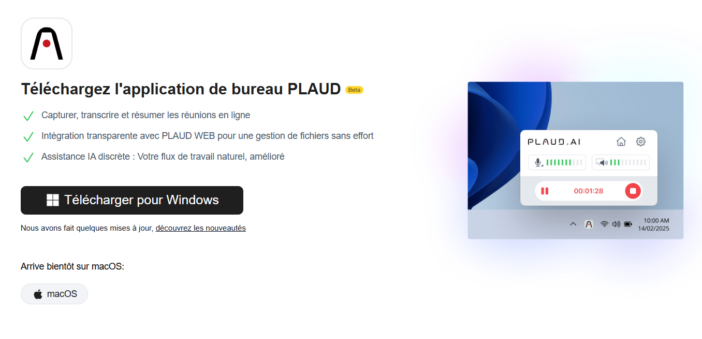
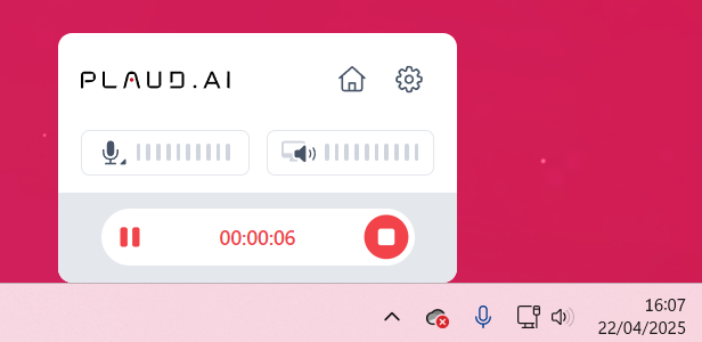
Or the addition of integrations to embed Plaud functions in other applications (Zapier, Microsoft 360, Notion, etc.).

In short, Plaud goes beyond being a simple recorder and has developed a complete ecosystem tailored for professionals.
Beware, however, of a few points: the limit of minutes on the free version can quickly be reached, especially if you record a lot. The Pro subscription then becomes almost essential for intensive use.
A Word on Data Security
Since the Plaud NotePin was primarily designed for professional use, it is safe to say that privacy is taken seriously. To ensure the protection of information, all data exchanged between the user’s device and Plaud's cloud servers is encrypted using the TLS protocol, supplemented by an additional layer of encryption specific to each user. Once stored, the information is protected by 256-bit AES encryption, recognized as one of the most secure on the market. Access to data is strictly reserved for its owner, thanks to personalized access controls that prevent any unauthorized consultation or modification. Plaud regularly audits its security measures to remain compliant with current standards and regulations, and continually adapts its practices to anticipate new risks. Data is hosted on Amazon Web Services cloud infrastructure, thus providing professional-level reliability and security. Finally, Plaud is actively pursuing compliance certification and is committed to informing its users of each advancement in this area while considering localized data processing to further enhance security and regulatory compliance.
Conclusion: Should You Go for the Plaud NotePin?
The Plaud NotePin has succeeded where other AI gadgets have failed: it offers real added value without complicating the user’s life. You quickly adopt it, you become attached to it, and it becomes a reflex in daily life. Admittedly, it has a cost (around €180 to purchase, plus the subscription for heavy users), but for those juggling meetings, interviews, classes, or brainstorms, it is an investment that quickly pays off.
It will not replace your smartphone, but it complements it beautifully, focusing on one essential task: capturing, organizing, and relaying information without friction. A real favorite for all those who want to gain efficiency… and keep a clear head for what really matters. For me, it has simply become indispensable in my job, whether at trade shows, during interviews, or even on construction sites.

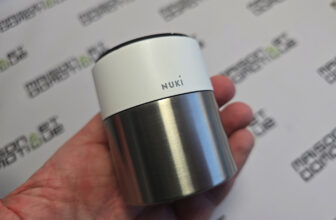
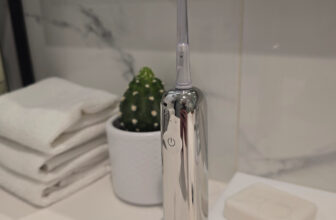
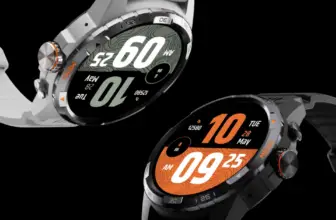
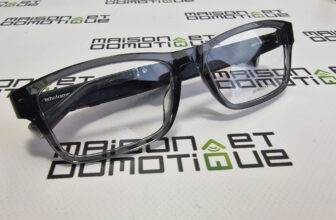

Please remain courteous: a hello and a thank you cost nothing! We're here to exchange ideas in a constructive way. Trolls will be deleted.